THE AIRPORTS
SOUTHERN CALIFORNIA
LOS ANGELES
LAX
1950s-1960s

| April
1955 A stunning lineup on the ramp on a bright spring morning at LAX. Five Douglas DC-7s get prepared for morning departures to the east including four American Airlines aircraft and a sole Continental Airlines airframe. At the front of the pack is N323AA "Flagship Wisconsin," a Douglas DC-7, delivered new to American Airlines a year earlier in April 1954. |
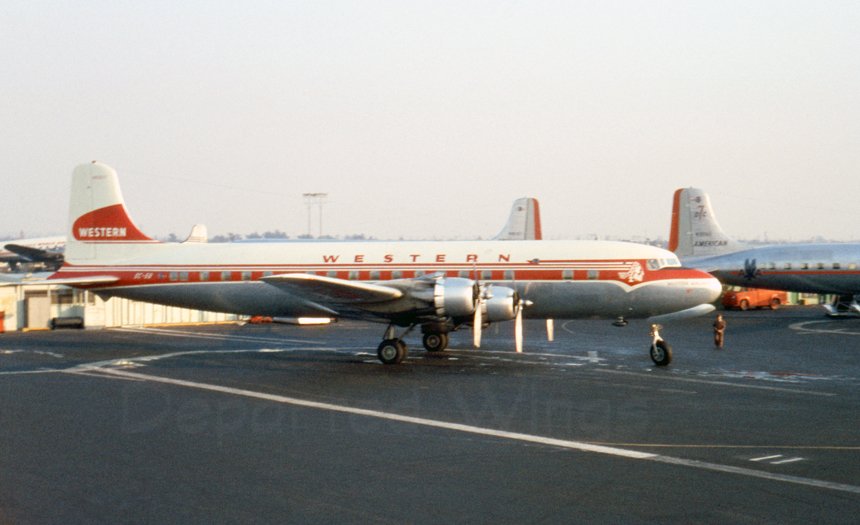
|
September
1957 Western Airlines truly had its roots planted in Los Angeles from the beginning, when an air-mail contract was awarded to Los Angeles based Western Air Express in 1926. The awarded route was a Los Angeles to Salt Lake City section via a stop in Las Vegas, Nevada. The flights started on April 17, 1926, from Vail Field in Los Angeles eastbound using a Douglas M-2 Mail plane. Passenger services started a month later in May over the same pioneering desert route. Over the next twenty years, Western Air Express grew to be a formidable carrier along the West Coast and had extended its wings as far east as Minneapolis, south to San Diego and north to Seattle and Edmonton, Canada. With a name change to Western Airlines in April 1941, the growing airline set a pace to continue to conquer the west. Seen preparing to depart the ramp area for an evening departure is N91307, a Douglas DC-6A, delivered new to Western Airlines in July 1954. |

| November
1957 Bonanza Air Lines was started in 1945, as local service carrier based in Las Vegas, Nevada. The airlines earliest route connected Phoenix, Arizona to Reno, Nevada on a multi-stop service using Douglas DC-3s. In July 1952, Bonanza started service from Phoenix to Los Angeles via seven enroute stops across the Southern Mojave desert using the venerable DC-3. Within a few years, flights were started to Las Vegas via Ontario and Apple Valley and eastbound to Phoenix via Riverside, Palm Springs, and Blythe. (The "southern" route to Phoenix via San Diego and Yuma continued to operate as well) Parked on the ramp during a bright fall morning is N496, a Douglas DC-3A-269C, originally delivered to United Air Lines in 1942, and purchased by Bonanza in August 1949. |
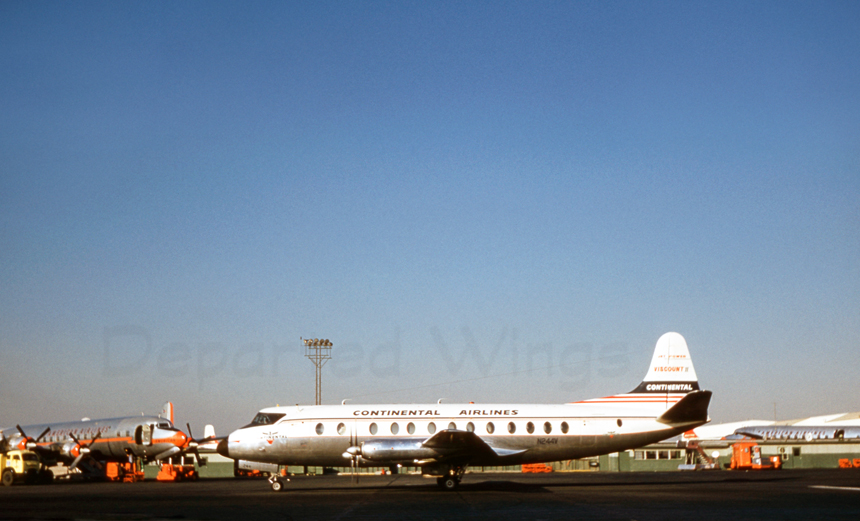
| October
1958 Continental Airlines took the bold step of placing an order for the British made Vickers Viscount turboprop, the world's first commercial turboprop aircraft. Continental was the launch customer of the more powerful 810 series, needed for the higher conditions at Denver's mile-high airport. Entering service on May 28, 1958, Los Angeles saw the new "Jet-Power" Viscounts on services to Denver. With the introduction of the Douglas DC-9, the Viscounts were finally removed from service in the late 1960s. Seen preparing to depart the ramp area for a morning departure to Denver is N244V, a Vickers 812 Viscount, delivered new to the airline in June 1958. |

| August
1959 One of the pioneering local airlines on the West Coast, Southwest Airways, started operations in 1941, as a flight school in Arizona. Realizing the need for passenger service, schedule operations began in December 1946, within California, using war-surplus Douglas DC-3s. By 1950, Southwest was operating a fleet of ten DC-3s and serving twenty-four towns and cities in both California and Oregon. As the airline continued to grow, it rebranded itself “Pacific Air Lines” in 1958, to better reflect the territory served. With the name change came continued growth and the airline looked at the new Fokker/Fairchild turboprop to increase capacity and distance on popular routes. Six new F-27 “Jet Hawks” were delivered to Pacific Air Lines in 1959, and were placed on high density routes such as San Francisco-Monterey and Los Angeles-Fresno. Pacific Air Lines would eventually operate thirteen of the Fokker aircraft before the company was merged with Bonanza Air Lines and West Coast Airlines to form AirWest in 1968. Seen holding in position for takeoff on Runway 25 Right during a mid-morning departure is, N2773R, a Fairchild F-27J delivered new to the airline on May 28, 1959. |
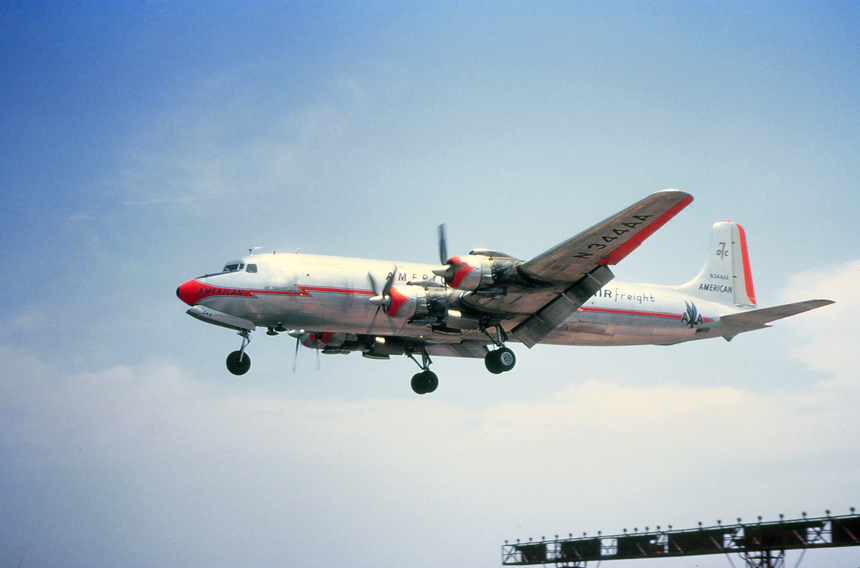
| April
1962 American Airlines entered the air freight market in 1944 using a converted Douglas DC-3 to fly cargo between New York and Burbank. The concept of providing a network of dedicated air cargo flights was continued and American led the way with innovative cargo handling and terminal facilities. As the airline retired their older piston-engined airliners, they found a new use for them as dedicated air freight carriers. Seen on short final to Runway 25 Left is N344AA, a Douglas DC-7B. |

| May
1962 During 1959, Bonanza Air Lines placed the 40-passenger Fairchild F-27 turboprop in service eventually replacing the Douglas DC-3 and becoming the first "First All Jet-Powered Airline in America." By 1962 all flights from Los Angeles to Las Vegas, Ontario, Riverside, and Santa Ana-Orange County were using the appropriately named Fairchild F-27 "Silver Dart." Seen parked on the tarmac at Satellite 3 and being prepared for an afternoon departure is N151L, a Fairchild F-27A delivered new to the airline on May 6, 1960. |
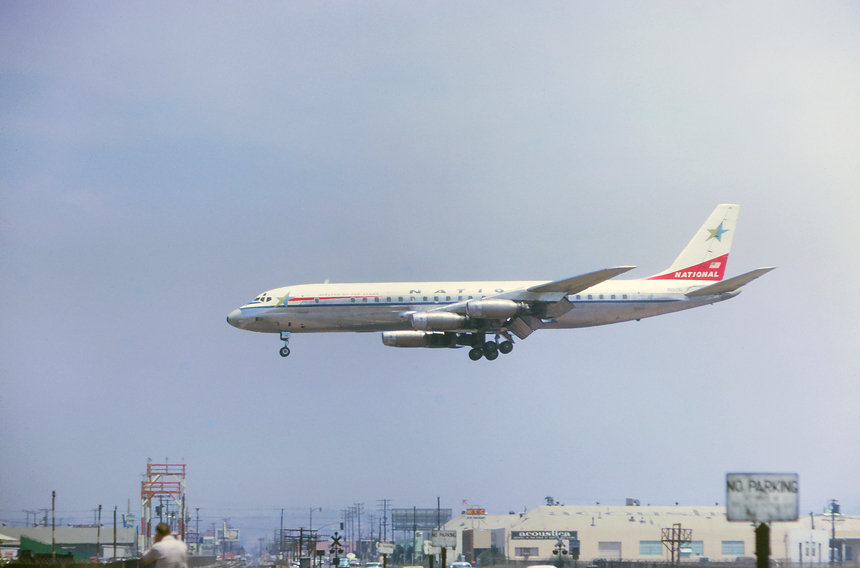
| July
1962 When National Airlines was awarded routes to California in March 1961, the airline placed its new Douglas DC-8 airplanes on the flights between Los Angeles and Tampa, Houston, and San Diego. Seen over busy Aviation Boulevard for landing on Runway 25 Right is N6571C, a Douglas DC-8-21, delivered new to National Airlines on February 7, 1960. |
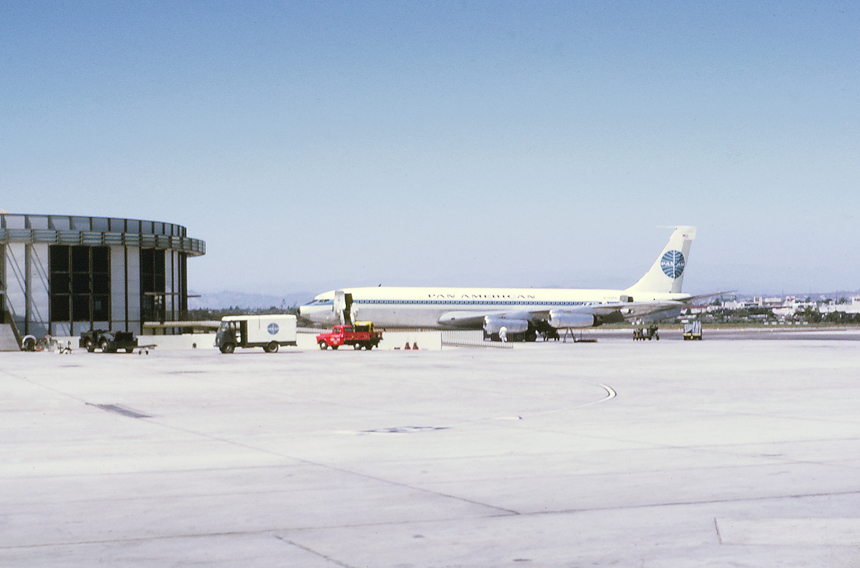
| August
1962 Pan American Airlines (Pan Am) first started service into the Los Angeles area in 1939, when China Clipper service was started between San Pedro Harbor and Honolulu, Hawaii. In 1950, operations were moved to Los Angeles International Airport (Mines Field) and the China Clipper was replaced with Boeing 377 Stratocruiser service to Hawaii. New non-stop service to Guatemala and Mexico City was later introduced in the early 1950s with Lockheed Constellations. Pan American received its first jet aircraft, the Boeing 707 in 1958, and in 1960, the new Boeing was introduced on the Los Angeles-Honolulu route. By 1962, Pan American had opened non-stop service from Los Angeles to London with the Boeing 707. Seen parked at the Satellite Terminal 2 building is N706PA "Jet Clipper Courier," a Boeing 707-331, originally delivered to the airline on June 6, 1960. |

| December
1962 As with all of the major carrier at the time, Continental Airlines was introduced to the Jet Age in 1959, when the airline placed into service the Boeing 707. Continental introduced the "Golden Jet" 707 on Los Angeles to Chicago service on June 8, 1959 Within a year, additional 707 flights were added from Los Angeles to Denver and Kansas City. Taxiing inbound toward the gate at Satellite 6 after a flight a N70773, a Boeing 707-124. This aircraft was damaged beyond repair during a landing accident at Kansas City Downtown Municipal Airport on July 1, 1965. |

| April
1963 American Airlines introduced Boeing 707 "Astrojet" service to the nation on January 25, 1959, when the first transcontinental flight took place using Boeing's newest jetliner. The plane, "Flagship California" departed Los Angeles at 0845 and headed eastbound to New York-JFK Airport. After a flight time of only 4 hours and 3 minutes, the plane landed amongst great fanfare, and entered into the history books with the start of the "Jet-Age." Seen having just been pushed back from the gate at Satellite Terminal 5 for an evening departure is N7512A "Pennsylvania," a Boeing 707-123B, delivered new to the airline on March 21, 1959. |
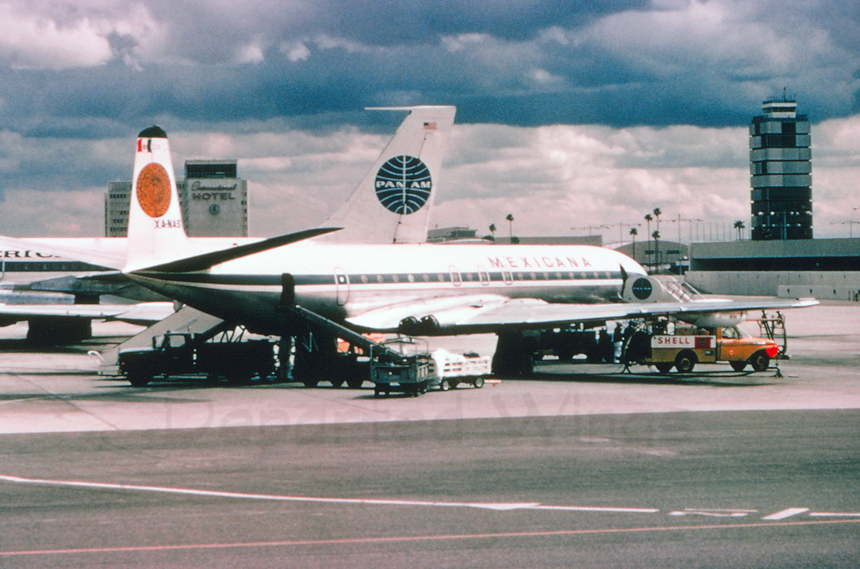
| April 1968 Mexicana was one of the few carriers that ordered the world's first, British made passenger jetliner, which opened the next chapter in commercial aviation history. The de Havilland Comet revolutionized speed and comfort, using four-jet engines and a pressurized passenger cabin. After some initial failures, the Comet was redesigned and rebranded for which Mexicana Airlines ordered four of the type for international services in 1959, however only three were delivered. The airline received its first Comet in January 1960, and placed the new jet on it's "Golden Aztec" service between Los Angeles-Mexico City on July, 4, 1960. Seen parked at Satellite Terminal 2 and being serviced for another departure southbound is, XA-NAS, a de Havilland DH.106 Comet 4C, delivered new to the airline on January 14, 1960. |
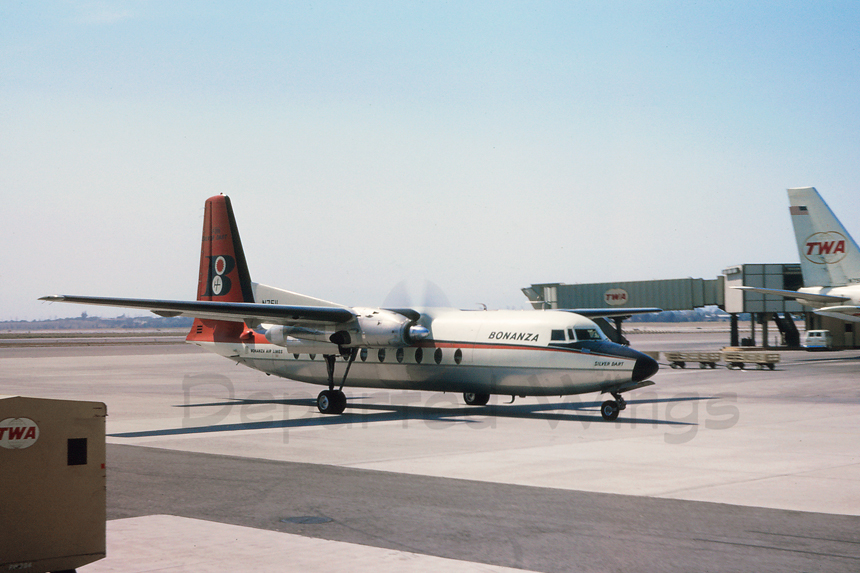
| May
1964 Los Angeles became a focus city for Bonanza Air Lines and by 1964, the Fairchild F-27 was flying to five regional cities from LAX; Las Vegas, Ontario, El Centro-Imperial, Santa Ana-Orange County, and Yuma. The regional airline provided important links to the desert communities of the east and important connections to both Phoenix and Las Vegas. Taxiing inbound the the gate at Satellite 3 during an afternoon arrival is N751L, a Fairchild F-27A. |

| January
1965 By 1965, Pacific Air Lines was using its "Jethawk" Fairchild F-27s on most of its flights from Los Angeles, included its longest, non-stop service between LAX and San Jose. Additional regional cities connected with the F-27 from Los Angeles included Bakersfield, Santa Barbara, Burbank, Fresno, and Long Beach. Seen taxiing away from the Satellite Terminal 6 for an evening departure is N2774R, a Fairchild F-27A, delivered new to the airline in June 1959. |
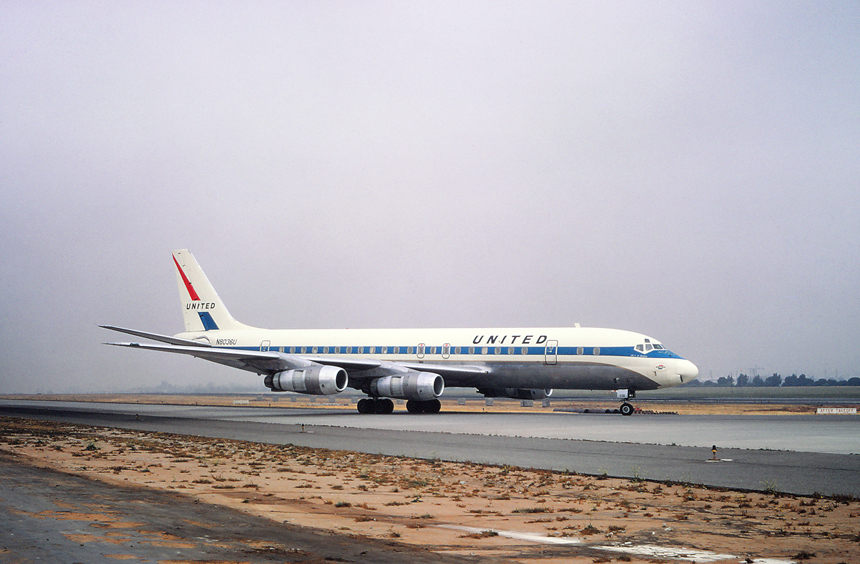
| June
1965 United Air Lines was one of the launch customers of the new Douglas DC-8, the first jet-powered aircraft to be designed and developed by the Long Beach based manufacturer. United placed an order in October 1955, for a staggering thirty aircraft at a total cost of $175 million, which was the largest single order for a civilian aircraft at the time. United's first aircraft was delivered in June 1959 and was initially used for training purposes. Passenger "Mainliner" services started on September 18, 1959, on a flight between San Francisco and New York-Idlewild Airport. Los Angeles soon saw the DC-8s on flights to Honolulu, New York, Detroit, Chicago, and Baltimore. Holding short of Runway 24 for a morning departure is N8036U, a Douglas DC-8-52, delivered new to the airline June 8, 1961. |
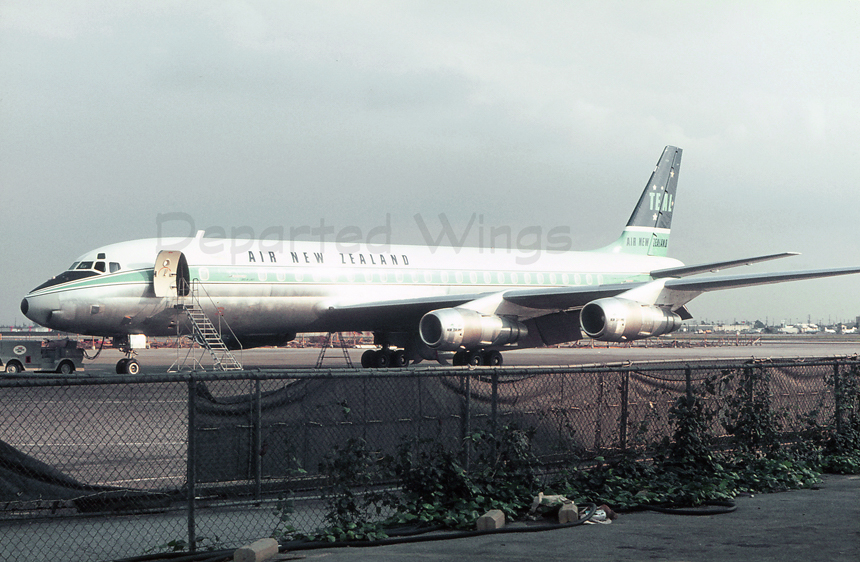
| December
1965 Air New Zealand placed an order for three Douglas DC-8s to provide "Jet" service on trans-Pacific routes. The first DC-8 was delivered in to the airline in July 1965, and allowed Air New Zealand to start pure-jet service to Honolulu and Los Angeles in 1966. Parked on the south ramp and being serviced is ZK-NZB, a Douglas DC-8-52, delivered new to the airline in August 1965. Only seven months later, this aircraft was destroyed in a training accident at Auckland International Airport on July 4, 1966. |
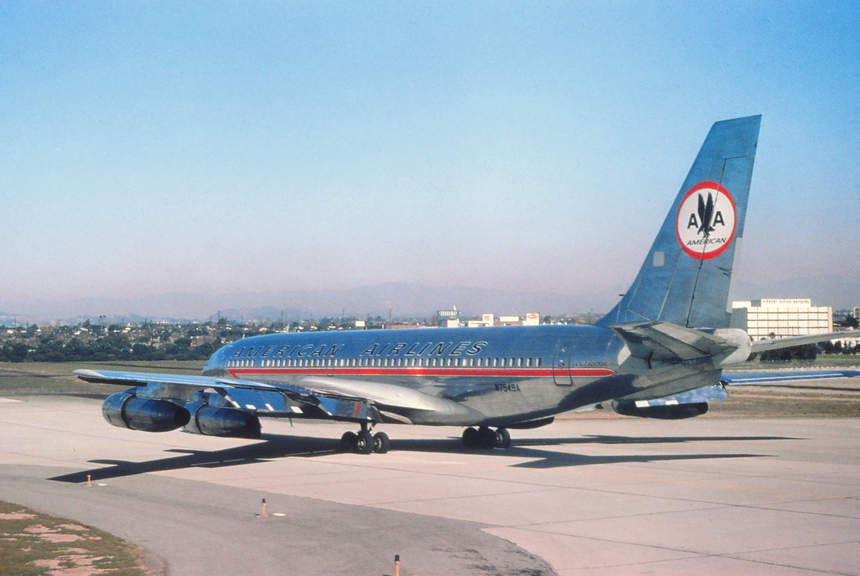
| May
1966 By the mid-1960s, American Airlines was using the Boeing 707 exclusively on transcontinental services with multiple daily flights from Los Angeles to Baltimore, Boston, Chicago, Cleveland, Detroit New York-JFK, and Philadelphia. Wearing an updated color scheme and showing the double "As" and eagle on the tail while taxiing up to Runway 24 for an afternoon departure is N7549A, a Boeing 707-123, delivered new to American Airlines in October 1959. |
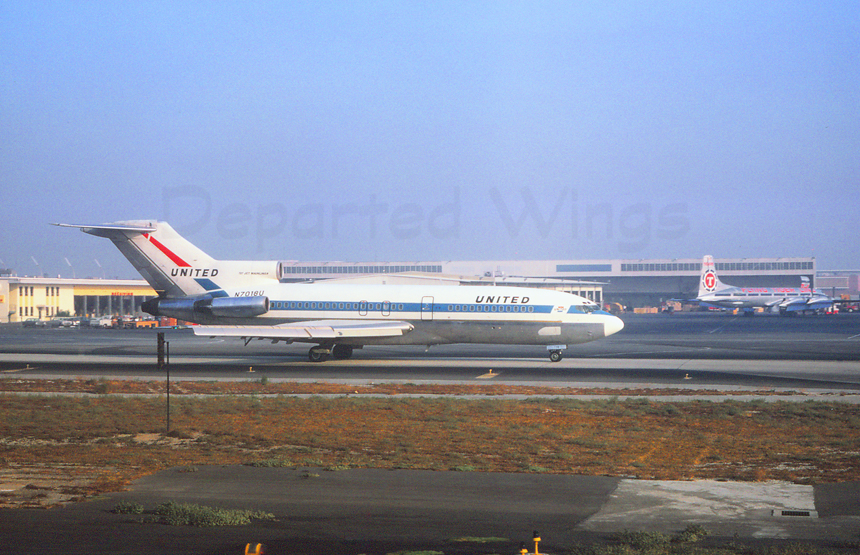
| May
1966 United Air Lines introduced the Boeing 727 in February 1964 on both short and medium routes in its flight network. Later that year, the airline introduced the Boeing 727 on "Jet Commuter Service" between Los Angeles and San Francisco to compete with both Western Airlines and Pacific Southwest Airlines PSA in that lucrative market. Seen taxiing out toward Runway 25 Right for an early morning departure is N7018U, a Boeing 727-22, delivered new to the airline on June 8, 1964. |
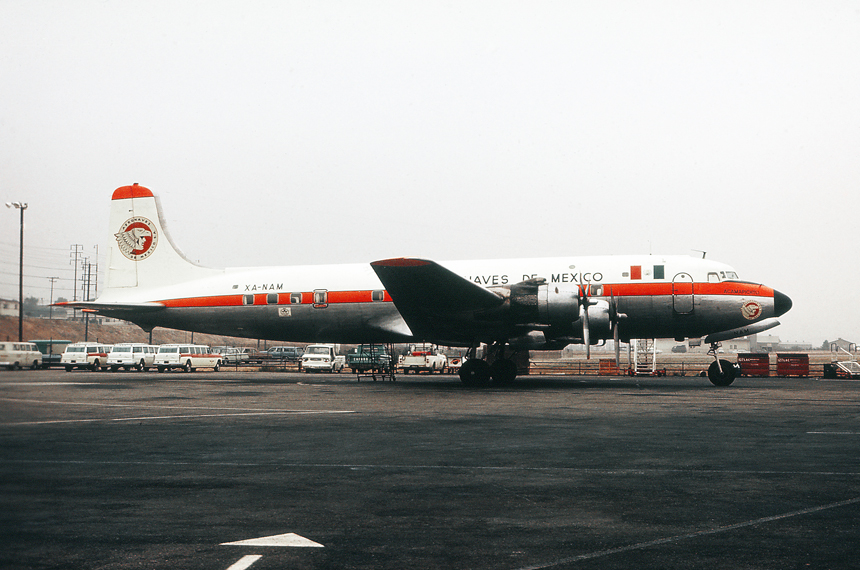
| April
1967 Aeromexico had started flights to Mexico in 1962, the second Mexican airline to do so after Mexicana Airlines. The airline had started flights with the Douglas DC-6 and transitioned to "jet" service in 1967 using Douglas DC-9s. Aeromexico still provided charter flights with its older piston-engined aircraft, as this example XA-NAM, a Douglas DC-6, parked at the Imperial Terminal. |
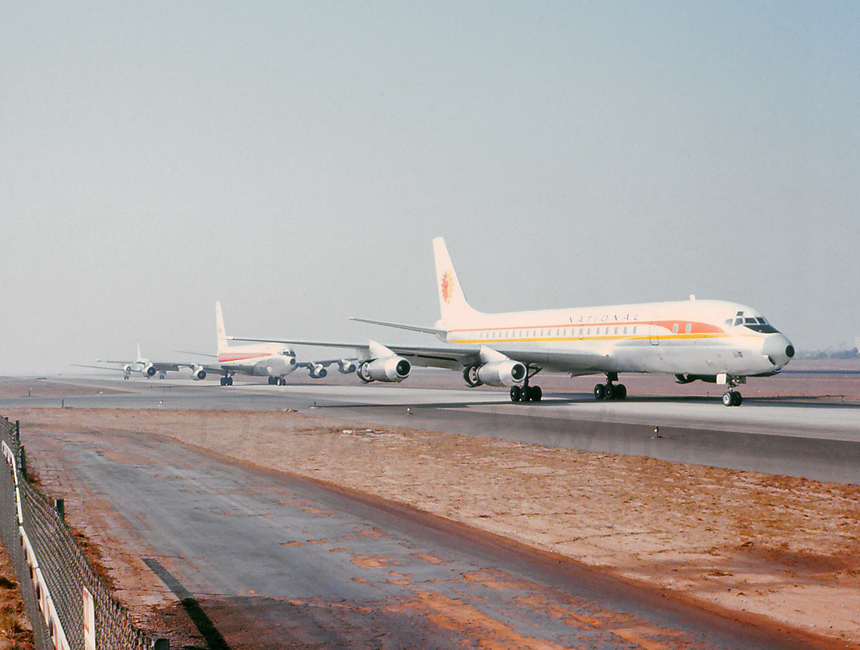
| November
1967 A hazy morning line-up as three airlines taxi toward Runway 24 for departure. Leading the pack is, N7181C, a National Airlines Douglas DC-8-32, followed by a Trans World Airlines TWA Boeing 707 and United Air Lines Convair CV-340. |
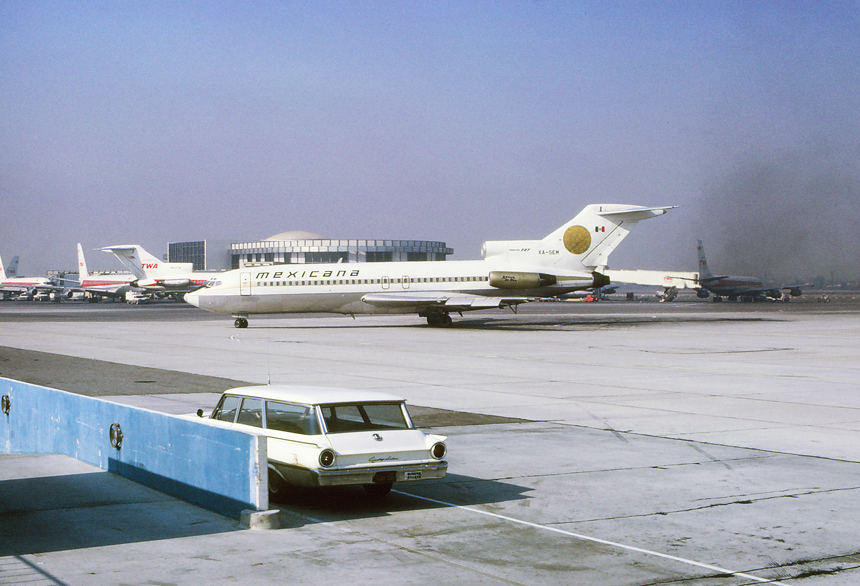
| December
1967 As the first international airline to serve the Los Angeles area when flights were started in 1936, Mexicana Airlines had a solid history with the LAX airport. Mexicana introduced the Boeing 727 in 1967 which would replace Douglas DC-4 and DC-6 aircraft and provide "MexJet" service on both domestic and international flights. During 1967, Los Angeles saw the Boeing 727 being used on flights to both Mexico City and Mazatlan. Seen taxiing into the gate at Satellite Terminal 3 and wearing the short-lived "Azteca de Oro" colors with the Aztec Calendar on the tail is XA-SEM, a Boeing 727-64. |

| April 1968 Mexicana Airlines continued to operate the Comet airliner along side the new Boeing 727s during the late 1960s. The pioneering British airliner alongside the flagship Mexico City route, had twice weekly services between both Los Angeles and Mazatlan and Puerto Vallarta. Seen turning onto Runway 7 Left for a afternoon departure under reverse traffic flow is XA-NAS, a de Havilland DH. 106 Comet 4C. Note the Air Canada Douglas DC-8 second for departure behind the Mexicana Comet. |
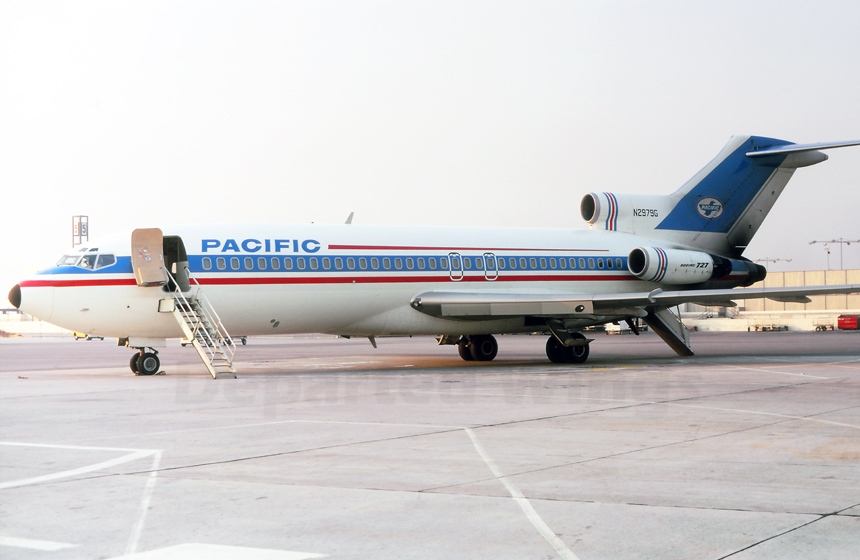
| April
1968 When other local service airlines were entering the jet age using the Douglas DC-9, Pacific Air Lines choose the still under development Boeing 737 to fill its needs. As a stopgap measure while waiting for the Boeing 737 program to produce its first aircraft, the airline leased a total of five Boeing 727s, however only three were initially operated. Flights with the Boeing 727 started in July 1966, on the most profitable routes including Los Angeles to San Jose, as well as on service between Los Angeles, Santa Barbara, Fresno, and Bakersfield. Seen parked on the ramp at Satellite 6 and awaiting passenger loading for an early evening departure is N2979G, a Boeing 727-193, delivered to the airline on August 5, 1966. |

| May
1968 When the Civil Aeronautics Board (CAB) approved the merger of Bonanza Air Lines, Pacific Air Lines, and West Coast Airlines in April 1968, the official merger of the new AirWest wouldn't be until three months later, however a new color scheme was soon applied to aircraft to promote the "new" airline, such as this example, N898PC, a Boeing 727-193 as it taxis toward the Satellite Terminal 6 after having landed on Runway 24 on an overcast morning. |
.jpg)
| June
1968 The new AirWest wasted no time in updating its fleet in the new "Fiesta Colors" including this example, N2772R, a Fairchild F-27A wearing the lime green/blue colors representing the Pacific Northwest, as it taxis toward Runway 24 during an overcast morning. |

| June
1968 Having being pleased with the initial order of Boeing 727-100s, Pacific Southwest Airlines (PSA), placed an order for the -200 stretch version in 1966. With a seating capacity of 158 passengers, the first Boeing 727-200 was delivered to PSA on December 19, 1967 and initially placed on the popular Los Angles-San Francisco route. Seen holding short of Runway 24 for a departing United Air Lines Boeing 727 on an overcast morning is N530PS, a Boeing 727-214, delivered new to the airline on April 2, 1968. |
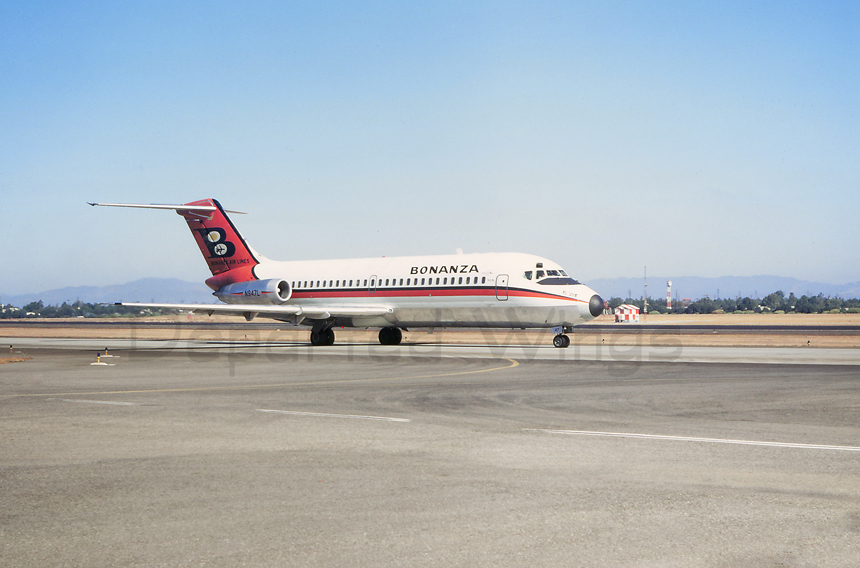
| July
1968 Bonanza Air Lines joined the true "jet" age when it received delivery of its first of three ordered Douglas DC-9 aircraft on December 21, 1965. Service was started with the DC-9 on march 1, 1996, and Los Angeles was one of the first cities to host the affectionately named "FunJet" on the airline's popular service to Las Vegas. Prior to the three-way merger with Pacific Air Lines and West Coast Airlines in April 1968, Bonanza was flying it's DC-9s from Los Angeles to Las Vegas, San Diego, and Tucson. Seen taxiing toward the terminal after having landed is during a morning arrival is N947L, a Douglas DC-9-11, delivered new to the airline in July 1966. |
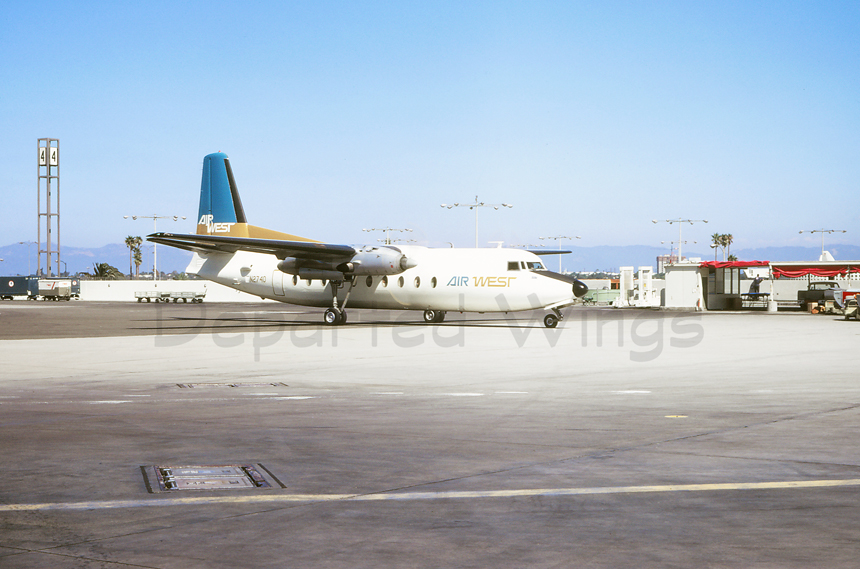
| August
1968 Painted in the two-tone sky blue/orche representing the San Francisco Bay Area as part of AirWest's Fiesta colors, N2740, a Fairchild F-27A taxis away from Satellite 4 for an afternoon departure. |
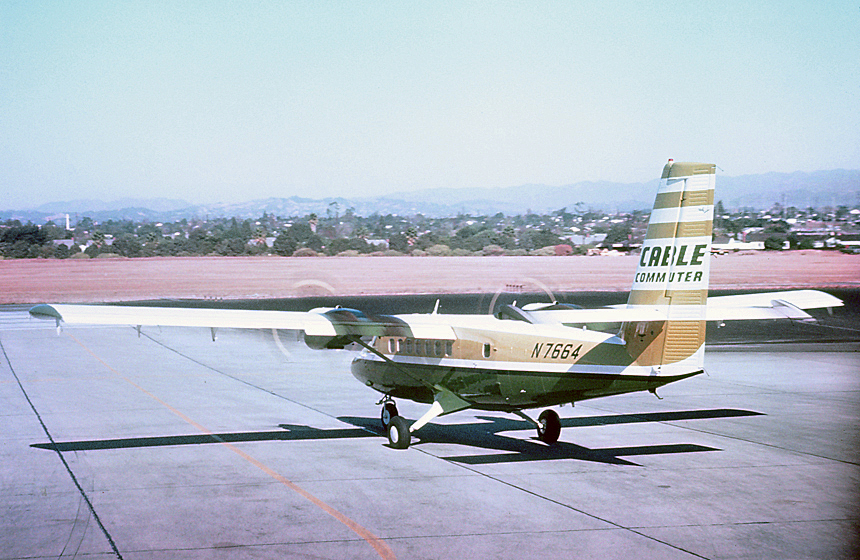
| August
1968 Established in January 1967, by a local businessman, Roger Cable, whom had a vision to connect the Inland Empire region of Southern California with air service to LAX. Based at Ontario airport the airline started with small twin-engined aircraft before purchasing twelve of the new de Havilland DHC-6 Twin Otter aircraft. Commuter services were introduced to Los Angeles in November 1967, with flights to Ontario, Palmdale, Inyokern/China Lake, and Orange County. Cable Commuter would be a regular operator into Los Angeles for just over a year until their consolidation into the new Golden West Airlines in 1969. Approaching Runway 24 for an afternoon departure is N7664, a de Havilland DHC-6-200 Twin Otter. |
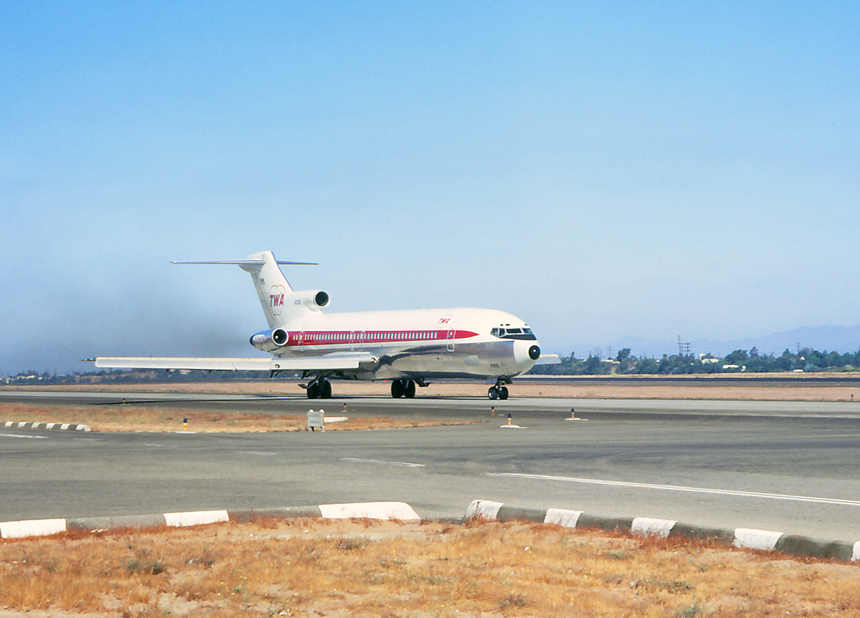
| August
1968 Trans World Airlines (TWA) in an effort to introduce jet service on its short-haul domestic market, placed an initial order for ten Boeing 727-100s in March 1962. The first plane was delivered on April 29, 1964 and placed into service between New York-JFK and Indianapolis. Los Angeles soon saw the TWA 727s on services to Albuquerque, Las Vegas, and Phoenix. Seen taxiing back to the terminal after having landed on Runway 24 is N12305, a Boeing 727-231, delivered new to the airline just a few months earlier in May 1968 |
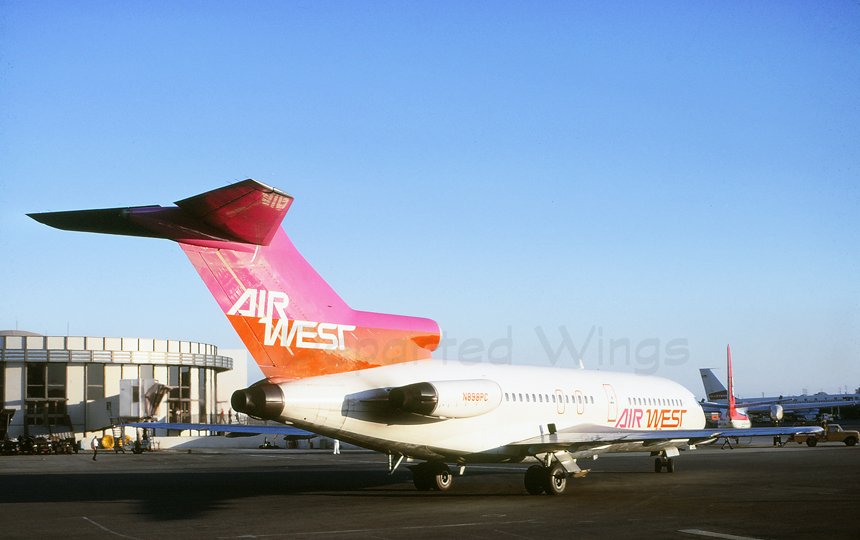
|
August 1968 AirWest took ownership of the three Boeing 727s that had been ordered and delivered to Pacific Air Lines with two being returned after a lease period to National Airlines in April 1968. The third 727 was returned to AirWest in November 1968 and placed into the route system. The Boeing 727 was a anomaly to AirWest as with only three airframes, additional maintenance costs and operating expenses made the aircraft uneconomical. The 727s were placed on the higher capacity trunk routes, such as on flights from Los Angeles to both Las Vegas and Salt Lake City. Seen pulling away from Satellite Building 6 for an early evening departure with the setting summer sun providing a vivid contrast is N898PC, a Boeing 727-193, delivered new to Pacific Air Lines on March 10, 1967. |

|
September 1968 Aero Commuter was another local airline established in December 1967, to provide "commuter" connections from smaller, regional Southern California airports into LAX. Based at Long Beach, Aero Commuter had its roots in providing flights to Catalina Island located just off the coast. With the addition of the de Havilland DHC-6 Twin Otters the airline increased flights throughout the region. Los Angeles had daily flights to El Monte, Burbank, Fullerton, Long Beach, Palm Springs, and Catalina Island. A year later in 1969, the airline would purchase two other local carriers (Cable Commuter and Skymark Airlines) and purchase the assets of defunct Golden West to become the "new" Golden West Airlines. Parked at the original commuter ramp on the west side of the terminal area is N63118, a de Havilland DHC-6-200 Twin Otter. |

|
September
1968 Pacific Southwest Airlines (PSA) ordered two Douglas DC-9 aircraft in 1967 to provide for pilot training but these aircraft were instead put into passenger service to better compete and add capacity on the popular Los Angeles-San Francisco corridor flights. The DC-9s were only in service for a few years until 1969 when they were replaced by both the Boeing 727 and 737 aircraft. Ironically during 1983, PSA purchased additional DC-9-30s for route expansion and used where the larger capacity MD-80s were not economical. Seen holding in position for takeoff on Runway 24 is N981PS, a Douglas DC-9-32, delivered new to the airline on March 23, 1967. |
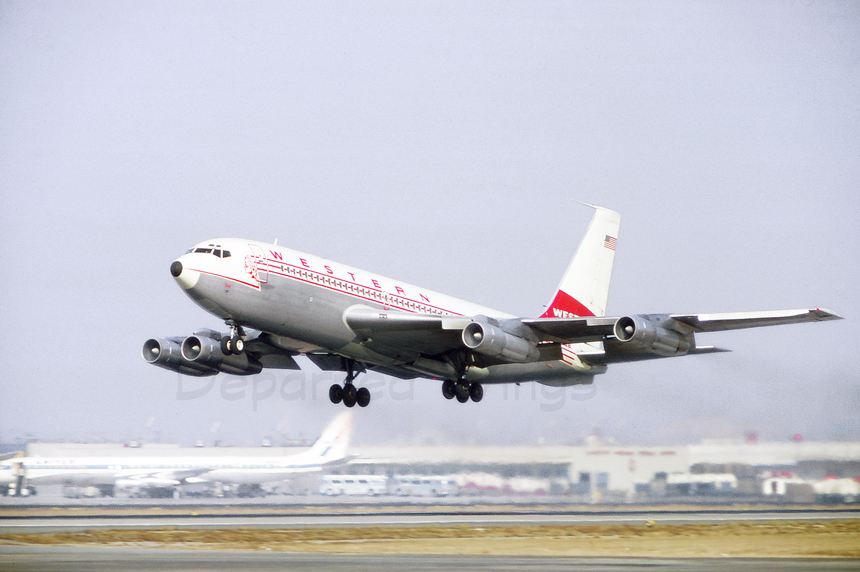
|
October 1968 Los Angeles remained a focal point to the airline’s operations, as well as the corporate headquarters being located at the airport. With the dawn of the “jet-age," Los Angeles played host to numerous Western Airlines firsts, including the introduction of Boeing 707 service on the Los Angeles-San Francisco-Portland-Seattle route. Seen taking to the skies from Runway 25 Right on an afternoon departure is N93144, a Boeing 720-047B, delivered new to the airline in July 1961. |
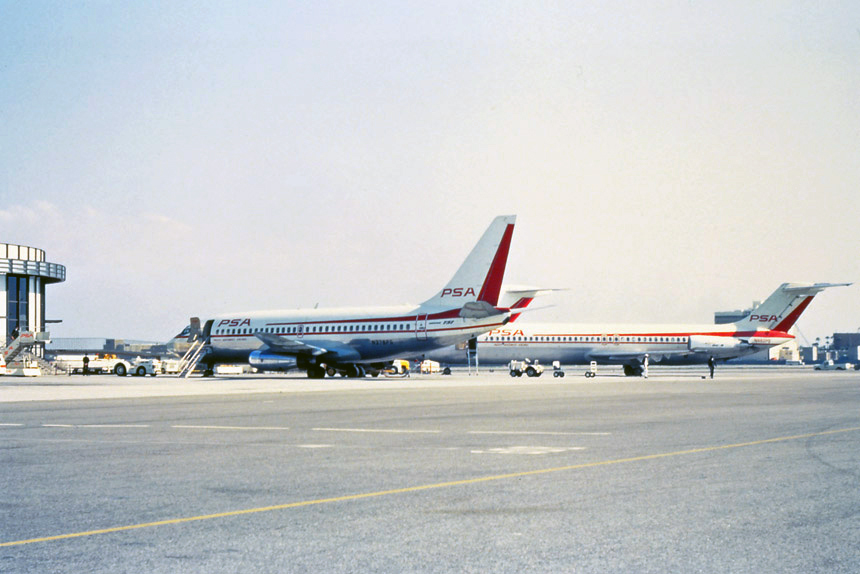
| November 1968 When Pacific Southwest Airlines (PSA) retired its last Lockheed L-188 Electras in September 1968, the regional airline became a truly all jet fleet using the Boeing 737 and 727 as well as the Douglas DC-9 on intra-state routes. A trio of PSA aircraft (737, DC-9 and 727) are seen parked at the Satellite Terminal 6, including newly delivered N378PS, a Boeing 737-214 and N982PS, a Douglas DC-9-32. |

| November
1968 Aeronaves de Mexico was formed in 1934, by Antonio Diaz Lombardo flying a route between Mexico City and Acapulco. Over the next thirty years the airline grew steadily adding international routes and becoming the flag carrier of Mexico. Anticipating more international routes and the airline entered the jet age by ordering the Douglas DC-8 and thus also beginning a long, positive relationship with the manufacturer. With the Douglas DC-8 being used on both international and high-density routes within Mexico, the airline sought a smaller jet airplane for domestic services. As expected the airline placed an order for the Douglas DC-9 Twinjet, the first being delivered in 1967, and being placed on the multi-stop Los Angeles-Mexico City route. Rolling out on Runway 25 Left after having landed is XA-SOY "Sinaloa," a Douglas DC-9-14, delivered new to the airline on July 19, 1967. |

| December
1968 VARIG Brasil took over the route of Redes Estaduais Aereas Ltda (REAL) Brasil which had started a multi-stop service to Los Angeles from Rio de Jeneiro in 1959. Flights were eventually extended to Tokyo, Japan and VARIG introduced jet service on the route with the introduction of the Boeing 707 in 1967. Seen holding short of Runway 24 is PP-VJJ, a Boeing 707-441, delivered new to the airline in November 1963. |
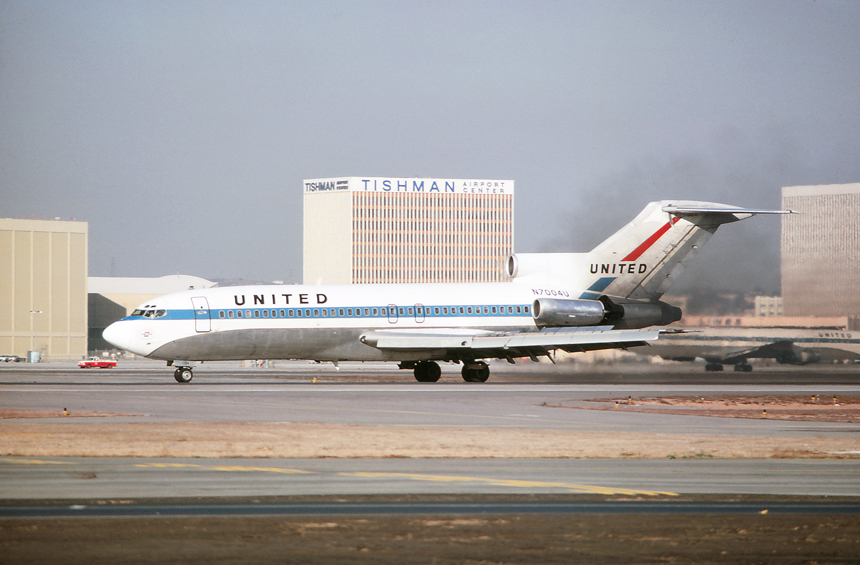
| January
1969 United Air Lines, as well as American Airlines and Eastern Airlines helped Boeing provide input on design and became launch customers of the tri-jet Boeing 727 in the early 1960s. With an initial order of forty aircraft, United took its first delivery in October 1963 and the plane was placed on short to medium range routings throughout the United network. Los Angeles saw the 727 soon scheduled on flights to Denver, Omaha, San Diego, Portland, and Las Vegas. Rolling out on Runway 25 Left and still in reverse thrust is N7004U, a Boeing 727-22, and the first 727 to be delivered to the airline on October 29, 1963. |
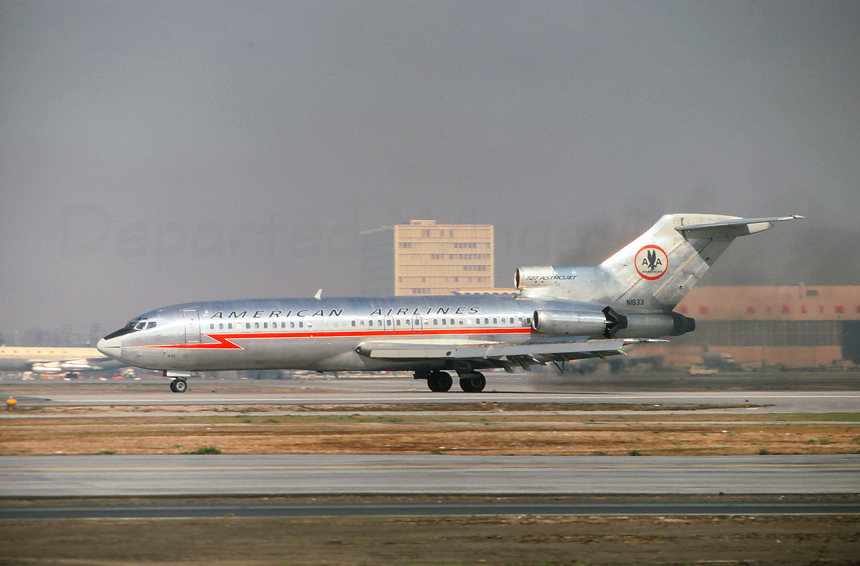
| February
1969 American Airlines placed an order for the Boeing 727 in 1960 to provide "jet" service on routes where distance and traffic density for the Boeing 707, Boeing 720, and Convair CV-990 was insufficient. American Airlines placed its first Boeing 727 in service on April 12, 1964 between New York and Chicago. Los Angeles soon saw the new "Astrojet" on services to El Paso, Oklahoma City, and St. Louis. Seen in reverse thrust on Runway 25 Left during an afternoon arrival is N1933, a Boeing 727-23, delivered new to the airline on January 20, 1967. |
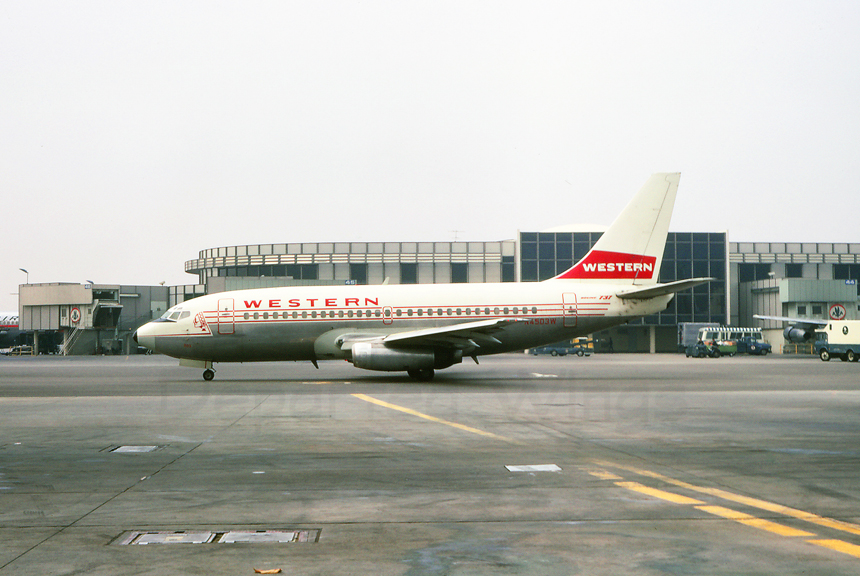
| February
1969 Western Airlines placed an initial order for thirty of the Boeing 737 Twin-Jet as an eventual replacement for the Douglas DC-6 and Lockheed Electra service in the "Lower 48." Western's first Boeing 737 in July 1968, and Los Angeles was one of the first airports to host the new plane on services to Ontario, Oakland, and Sacramento. Seen preparing to taxi from the ramp at Satellite 5 for a midday departure is N4503W, a Boeing 737-247. |
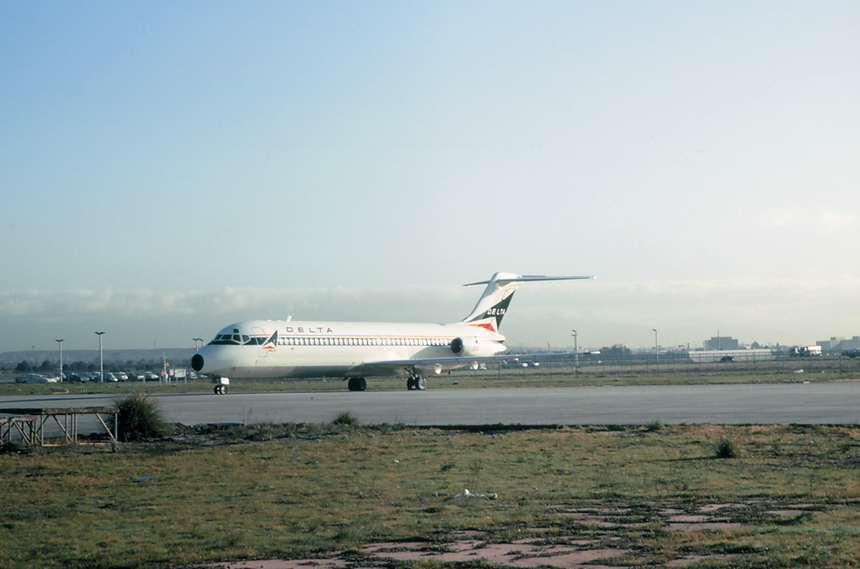
| March
1969 Although at the time, Delta Airlines was not a scheduled carrier at the airport, Delta aircraft were occasionally seen "passing" through after having been delivered by Douglas Aircraft just south in Long Beach. This brand new Douglas DC-9 was delivered new to the airline the day before and stopped by LAX, before being flown to the carriers home base of Atlanta, Georgia. Parked at the remote parking ramp at the west end of the airport in "mint" condition is N1273L, a Douglas DC-9-32. |
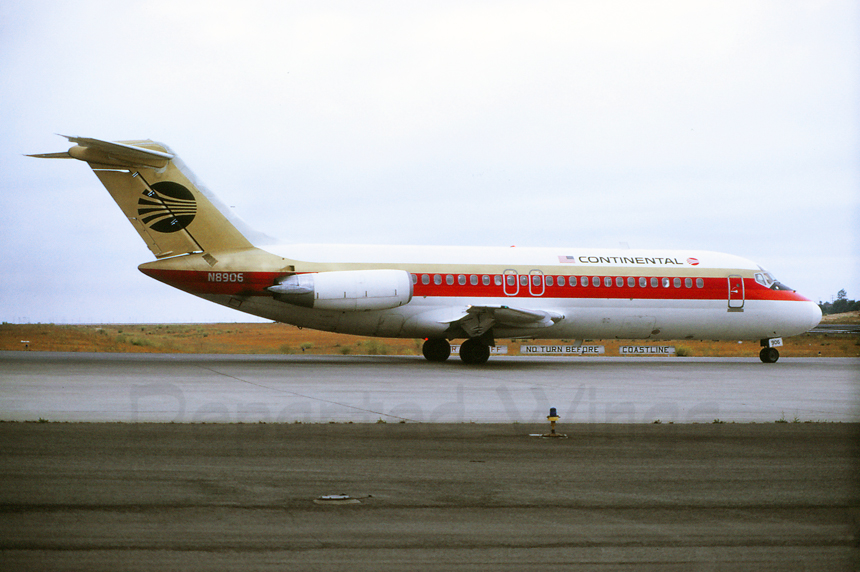
| May
1969 During 1965, Continental Air Lines launched the "Rapid Change (RC)" version of the Douglas DC-9 and placed an order for twelve aircraft. Continental President at the time, Robert "Bob" Six saw a potential air freight market utilizing the new short-range jet aircraft and theorized that passenger and cargo could be changed rapidly depending on the demand. The "RC" model had a large main deck cargo door on the left side of the aircraft, removal cabin dividers and a palletized floor allowing carriage of pure cargo, mixed configuration or full passenger configuration. Although the rapid change concept was visionary, Continental rarely operated a main-deck cargo flight with the planes. The first RC was delivered to Continental in 1967 and used on various short to medium range distances. Los Angeles saw the Douglas DC-9 used on flights to El Paso, before the Boeing 727 replaced them on the mainline services. Seen holding short of Runway 24 for a departure on an overcast morning is N8906, a Douglas DC-9-15RC. |

| May 1969 When Bonanza Air Lines, Pacific Air Lines and West Coast Airlines merged in July 1968 to form AirWest, the new airline assumed the operation of ten (10) Douglas DC-9s that had originally been operated by both West Coast (4) and Bonanza Air Lines (6). Los Angeles continued to be served with the DC-9s under the AirWest brand until its purchase by Hughes Corporation in 1970. Seen taking to the air and departing Runway 25 Right is N9330, a Douglas DC-9-30, originally scheduled to be delivered to West Coast Airlines however was delivered new to AirWest in May 1968. |
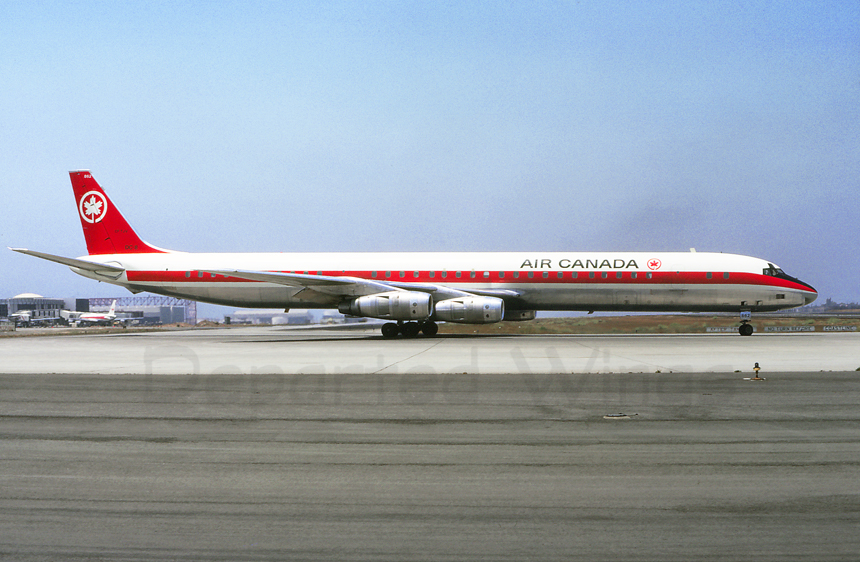
| July
1969 The national airline of Canada, Air Canada started service to Los Angeles in 1967 with non-stop flights to Toronto using two versions of the Douglas DC-8 that the airline was operating. Air Canada took delivery of its first "stretch" version of the Douglas DC-8, the -61, with seating for 205 passengers needed for the higher density routes, including the daily "Maple Leaf" services Los Angeles. The airline was the first to connect Los Angeles with Canada's largest city, Toronto. Seen taxiing toward Runway 24 for a morning departure is CF-TJV, a Douglas DC-8-61. |

| July
1969 New regional airline AirWest utilized its fleet of Douglas DC-9 "jets" on its major trunk routes throughout the system including regional flights from Los Angeles to Las Vegas, Tucson, and San Diego. Caught "over-the-numbers" for landing on Runway 24 (the north runway had not been constructed yet) is N9337, a Douglas DC-9-30, delivered new to AirWest in march 1969. |

| July
1969 Displaying the "Fiesta" colors brightly on a bright summer morning, N9104, a Douglas DC-9-14 awaits on the tarmac at Satellite 5 for passengers to start loading. Interestingly, this aircraft was involved in an accident seven years later on November 16, 1976, while operating for Texas International Airlines. The aircraft was starting a flight from Denver to Houston-Intercontinental when during the takeoff roll, the stall warning sounded on rotation and the pilot rejected the takeoff resulting in the DC-9 over-running the runway and being damaged beyond repair. Fortunately there were no serious injuries to the eighty-one passengers or five crew members. |
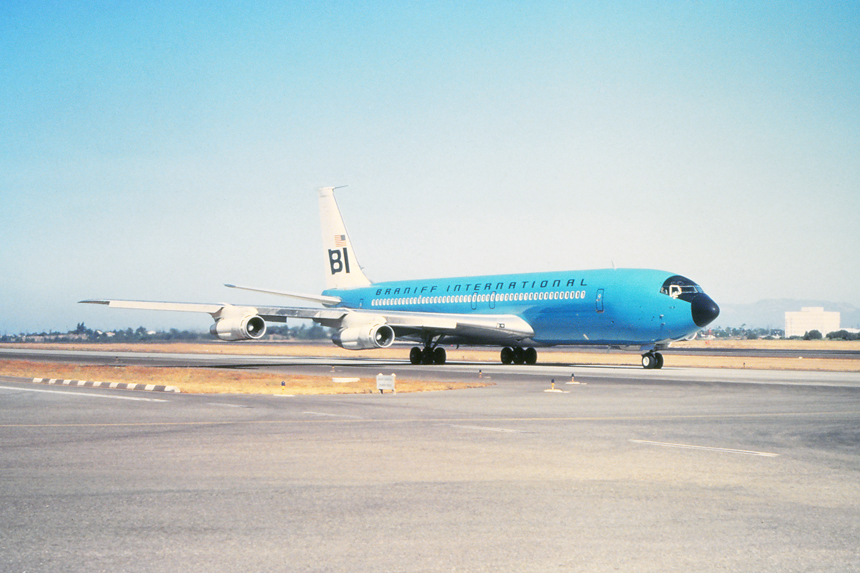
| August
1969 After the purchase of Panagra Airlines in 1967, Braniff International Airlines assumed the routes between Los Angeles, Bogata, Columbia and Lima, Peru. Although Panagra was operating Douglas DC-8s on the international service, Braniff started operating Boeing 707s on the routes to supplement the DC-8s. Caught taxiing back to the terminal after having landed and wearing the new blue "Jelly Bean" colors is N7103, a Boeing 707-327C, delivered new to Braniff in October 1967. |

|
September
1969 In 1967, industrial designer Henry Dryfuss was retained to create a new identity for the airline. After much iteration, a design of red, white, and blue was chosen with a new logo of double “A”s each in blue and red. What was initially missing was the popular eagle which had been used with American Airlines since 1931. After much uproar, a smaller, stylized eagle was placed between the two A’s. The new “colors” started to replace the lightning bolt scheme in 1968, and would go on to be one of the longest lasting airline liveries seeing service until 2013. Seen having just touched down on Runway 25 Left is N6838, a Boeing 727-223. |

|
December 1969 Frontier Airlines was formed in 1950 as the result of the merger of three local service airlines; Monarch Airlines, Challenger Airlines and Arizona Airways. The new airline, Frontier was based in Denver, Colorado and focused its initial flights in the Mid-West and Rocky Mountain region. Boeing 737s were ordered in the late 1960s to replace the Boeing 727 that were too large for the regional airline's route structure. The Boeing 737 would become the primary aircraft for Frontier until the airlines purchase by PEOPLExpress in 1985. Los Angeles was not a regular destination for Frontier until 1980, however the airline would occasionally fly charters into the airport previous to starting scheduled passenger services. Caught parked at the Imperial Terminal and unloading passengers during a winter charter flight is N7371F, a Boeing 737-2CO, the first example to be delivered to Frontier in May 1969. |
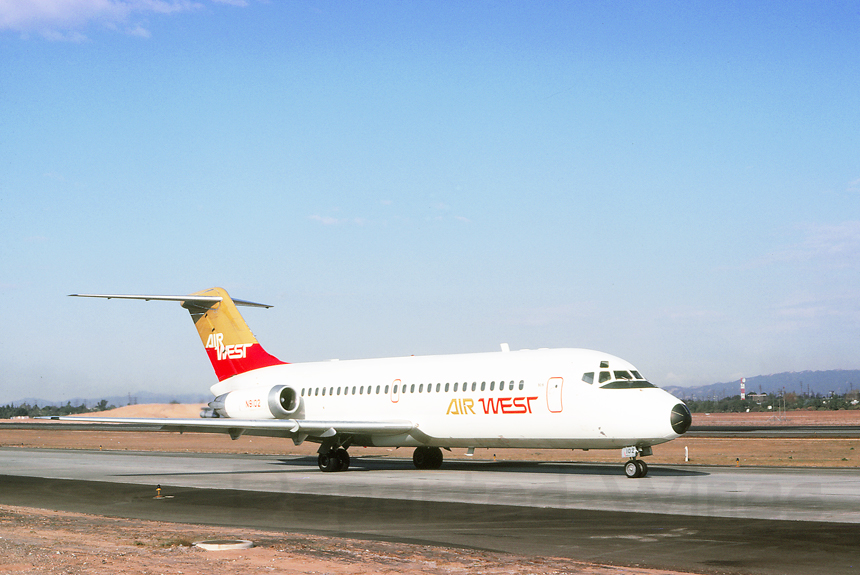
| December
1969 With the formation of AirWest in July 1968, the new airline took over the three DC-9s that were being operated by West Coast Airlines as well as a fourth that was to be delivered in May 1968 but subsequently up taken by the new AirWest. Seen wearing the "Fiesta" colors representing the Mexican Baja coastal region and taxiing back toward the terminal after having landed is N9102, a Douglas DC-9-14, delivered new to West Coast Airline son November 4, 1966. |
Continue with: Los Angeles-1970s
Back to: Los Angeles-Index or The Airports